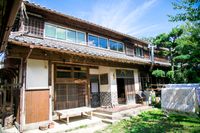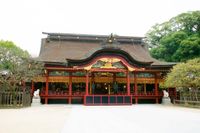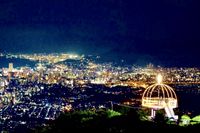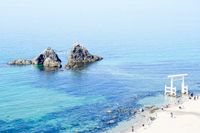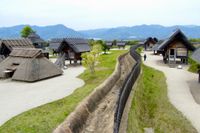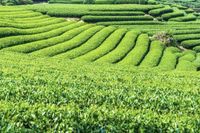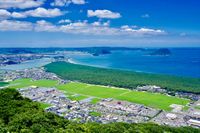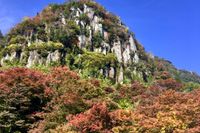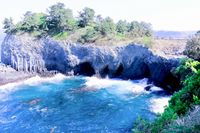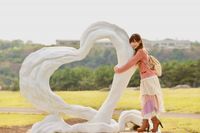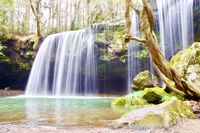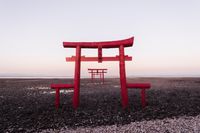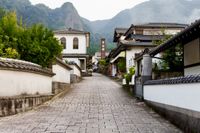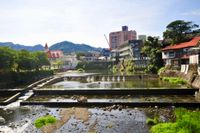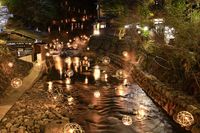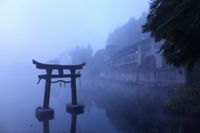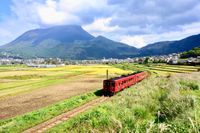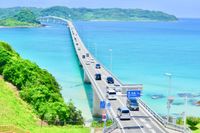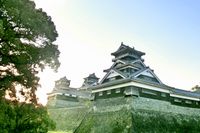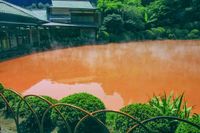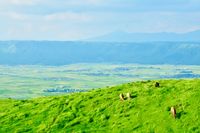Nanzoin Temple
福岡県/糟屋郡篠栗町

Description
This is a Shingon sect main head temple built in 1899, as a temple from Mount Koya. Nanzoin temple had provided Burmese and Nepalese children with medical aid, milk and stationery over the years, and as a return gift, the Myanmar national buddhist institution gifted various buddhist relics, known as Sarira. In 1995, a 41 meter reclining buddha statue was built to enshrine these buddhist relics. Other areas to look out for which are relics of its history are the buddha footprint, 500 arhats and the Seven Deities of Good Fortune tunnels.
Homepage
Address
Nearby Car Night Spots
There is no nearby car night spots
Nearby Activities
Ranking Stations
Vanlife BASE | 45 min. from Narita Airport / Perfect for campervan travel/A seaside town rich in nature/Japanese countryside town/welcome traveler
¥7,000〜
/ per nightChiba Koseki, Kujukuri-machi, Sambu-gun
5.0
(61)(Bonfire BBQ) Chita Mihama Noma Beach Station
¥3,500〜
/ per nightAichi Noma, Mihamacho, Chita County
4.7
(42)Nearby Drive Spots
Dazaifu Tenmangu Shrine
This is a temple built in 919 AD by Fujiwara Nakahira. The great heavenly God Sugawara Michizane is enshrined in this temple, and there is splendid Shinto architecture above the grave of this God. It is a popular site of reverence for students, as this temple God is known as the deity for learning and study, and along with the Kitano Tenmangu Shrine in Kyoto, this is the main head temple of the Tenmangu shrine group, which consists of around 12,000 shrines. The area is famous for Tobi Ume plums, and each year, a priestess will donate a plum tree to the country, and is also used for plum wine.
Mount Sarakura
This is a 622 meter high mountain situated in Norther Kyushu. The view of Kyushu below from the top of the mountain is known as the "10 billion dollar view". There are endless destination for visitors, including the rock climbing practice area, Kunimi rocks, the stunning cedar trees known as "Empress cedar" as well as camping facilities.
Couple Rock(Sakurai Futamigaura)
This is a collection of sacred rocks in Futamigaura, the western part of Fukuoka prefecture. The rocks are sacred forms from the Sakurai Shrine, and each "Male" rock is from Izanagi (a legendary male God) and the "female" rocks are from Izanami (a legendary female God). The views of the sunset that peeks between the rocks is a sight to behold, and cherished by many visitors that come here.
Yoshinogari Historical Park
This is the largest ruins area from the Yayoi era (around 500 BC). The biggest characteristic is the collection of relics associated with the defense of the settlement, with about 2.5 km of outer bunkers and fences. In addition, as from excavation survey findings, pit dwellings, tall floor warehouses, observation towers, tombs, bronze ware, copper mirrors and the like have been discovered over an area of 36 hectares, making it a very important historical site which tells the story of the lives of people in ancient times.
Yame Chuo Tea Garden
This is a tea field situated in Yame city. It is the 6th largest tea producer in Japan, and makes up 3% of Japan's tea. Tea leaves have been grown here since the Sengoku era(1467-1600), and has spread in prominence and popularity since them.
Niji no Matsubara
This is a pine grove in Karatsu bayside, Saga prefecture. With a width of 500 meters and a length of 4.5 km, there are around 1 million pine trees that line the forest, and is a rare sight due to their proximity to a coastal area. During the Edo era(1603-1868), it is believed that these pine trees were purposely planted here to act as a barrier to the coastal winds.
Yabakei Gorge
This is a valley in the northern part of Oita Prefecture, one of the three most famous in Japan. It is an extremely old value which has stellar views of the rock formations made by the volcanic activity from around 2.6 million years ago and has views of numerous unusual rock formations. There are countless spectacular scenes along the way, and they are collectively referred to as the sixty-six landscapes of the Yabakei Gorge.
Nanatsugama Caves
This is a row of sea caves that exist side by side along the coast of the northern part of Saga Prefecture. Because it originally had seven sea caves, it was named "Nanatsugama", although in the present day, there are more than seven caves. It is an unexplored area where you can see the mysterious scenery that nature has created.
Cape Hado
This is a cape in the Eastern Matsuura peninsula in the Northern part of Saga prefecture. As the pronunciation of the place name is similar to "haato" (Heart in Japanese), it is also known as a sacred spot for couples, and there is a heart shaped monument to represent this. There are also plentiful facilities for water activities, lodgings and camping, a seaside sand park and a Tsuboyaki area (Tsuboyaki is a method of putting ingredients inside a container and then cooking them while in the container).
Nabegataki Falls
This is a hot spring in Unzen city, built in 701 AD. From the Edo era(1603-1868) up until the Meiji era(1868-1912), it developed as a resort area for many foreigners who visited Nagasaki, with Sea Bolt being one of the first. The 30 Onsen have the smell of the naturally occurring sulphur and smoke, known as the "Unzen hell". It also has a sad history of being witness to Christian martyrdom.
Ouo Shrine
This is a shrine built around 1700. There is a legend that says that an officer who was stranded on Okinoshima island was saved by a large fish, and built Torii gates in the water, which is now commemorates as a protective sea God. At low tide, it is possible to walk through the Torii gates along the sea path, but these are submerged at high tide.
Okawa Uchiyama
This is a town known as the "Secret kilin town" from 1675. The Nabeshima clan, inhabitants of the town were the first to master porcelain production, and established the "clan kiln" as well as other technologies to improve the quality of their products, and it was said that steps were taken to ensure that these techniques were not known to others to copy. They maid luxury porcelain products for the Daimyo, Shogunate and imperial court up until 1871, but is still cherished today as a porcelain specialist town where traditional production kilns can still be viewed.
Ureshino Onsen
This is an area with a small hot natural hot spring in Southern Saga prefecture. It has 1900 years of history with several traditional Japanese inns along the Ureshino Rivers, making it one of Kyushu's largest Onsen towns. The Onsen is popular with women due to the water's skin enhancing properties. It also has a special local product known as Ureshino Onsen tofu.
Kurokawa Onsen
This is an onsen in the northern part of Mount Aso. It is one of the most well recognized Onsen areas, with 2 stars from the Michelin tourism guide. It was built with the concept of the town roads being a "corridor" with each guest inn as a "room", and was built whilst maintaining integration with the natural surroundings. It is popular for those visiting several different Onsen.
Yufuin Onsen
This is an Onsen close to Kinrin Pond, which is at the foot of Mount Yufu. The volume of hot spring water is the second largest in Japan. It has the distinct characteristic of having numerous luxury traditional Japanese lodgings which are integrated into the natural surroundings with the minimum of disturbance. The central Yufu street in this area has many fashionable miscellaneous goods shops, and restaurants, making it popular with visitors young and old.
Mount Yufu
This is a 1583m high active volcano in Yufu city. Due to its resemblance to Mount Fuji, it is sometimes called the "Bungo Fuji". It has been historically known as a site of worship and object of reverence, and also appears as a holy mountain in the "Kojiki" anthology. It is ideal for those who don't wish to climb the mountain as well as the railway is also popular with train enthusiasts, with the route having amazing scenery of Mount Yufu in its backdrop.
Tsunoshima Bridge
This is a 1780 meter long bridge in Yamaguchi prefecture, Shimonoseki City, which stretches across to an island. It has been often used as a filming location for movies and adverts due to its ideal location, and attracts many visitors due to its stunning views. It is recommended to see the southern and front observation decks for the best views.
Kumamoto Castle
This is one of Japan's three most famous castles, built in 1607 by Kato Kiyomasa. The castle is famous for being the place where Miyamoto Musashi, the most famous Japanese sword warrior and author of the martial art "book of five rings" spent his later years, as well as being the scene to the Southwestern War, the final civil war in Japanese history. The main hall known as the "Shokun no Ma" represents the grandiose and opulent Daimyo culture. The castle was damaged by the Kumamoto earthquake of 2016, but has been restored.
Beppu Onsen
This is a hot spring bath in Beppu City. It has 1300 years of history, and boasts the highest volume of natural hot spring water in Japan. It was built around the 8 Onsen towns known as the "8 baths", and due to the sulphuric smells, it has a famous "Beppu hell tour" with the "water hell", "blood pond hell", "white pond hell" and "tornado hell". There are also plenty of sand baths and bedrock baths.
Mount Aso
This is an active volcano situated in the Aso region of Kumamoto prefecture, where plumes of smoke can still be seen. An eruption from around 90,000 years ago formed the largest caldera rock formation of 380 square kilometers, which provides stunning views. At the foot of the mountain, there are camp facilities, as well as horse riding and star gazing which can be enjoyed by visitors.

